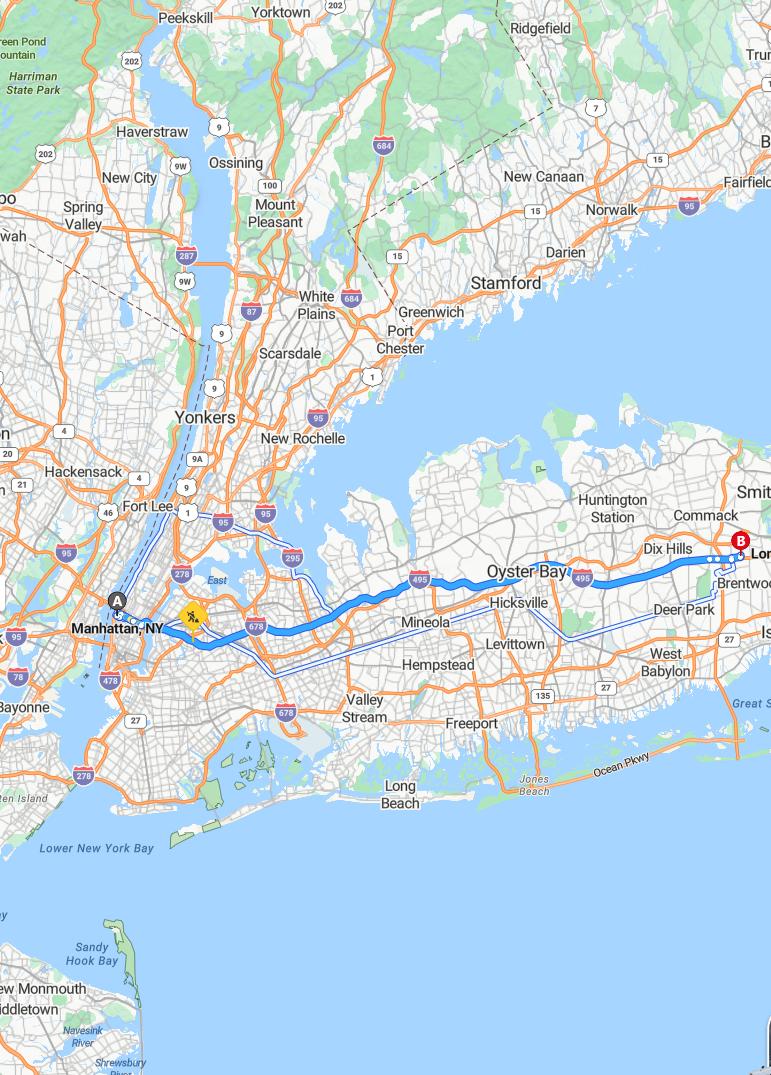Distance and estimated driving time
The drive from Manhattan to Long Island typically takes approximately 1 hour and 1 minute, covering about 42.5 miles. Most travelers use the I-495 East highway for a direct and efficient route. Traffic conditions can vary, so it's advisable to check real-time updates before starting the journey. Planning accordingly ensures a smooth and timely trip from Manhattan to Long Island.
Driving route
Traveling from Manhattan to Long Island typically begins with a scenic drive across the East River via one of the several bridges or tunnels, such as the Queensboro Bridge or the Queens-Midtown Tunnel. As you leave Manhattan, you'll pass through the borough of Queens, which acts as a gateway to Long Island, offering diverse neighborhoods and urban landscapes. The route often involves merging onto major highways like the Long Island Expressway (I-495), facilitating a smooth transition into Long Island's more suburban environment. Along the way, travelers can enjoy views of the city's skyline transitioning into the open spaces and coastal areas characteristic of Long Island. This journey highlights the seamless connectivity between New York City and its neighboring suburban regions, making it a convenient route for commuters and visitors alike.

Best departure times to avoid traffic
To minimize traffic congestion when driving from Manhattan to Long Island, it is best to depart early in the morning, ideally before 6:30 am, when the roads tend to be less crowded. If an early departure isn't possible, consider leaving after 9:30 am or during mid-afternoon hours, such as between 2:00 pm and 4:00 pm, to avoid peak rush hours. Avoid traveling during weekday evenings between 4:30 pm and 7:00 pm, as this is when traffic along the East River and through Queens is typically heaviest. Planning your trip during these optimal times can significantly reduce travel time and make for a more comfortable journey.
Parking options near Long Island attractions
Parking options near Long Island attractions vary depending on the specific destination. Many popular sites, such as Jones Beach or the Long Island Aquarium, offer dedicated parking lots with convenient access for visitors. Additionally, some attractions in towns like Port Jefferson or Huntington provide street parking or nearby public parking garages. It is advisable to check individual venue websites in advance to confirm parking availability, rules, and fees to ensure a smooth visit.
Toll information and payment methods
When driving from Manhattan to Long Island, travelers may encounter tolls along certain bridges and tunnels, such as the Queens Midtown Tunnel and the Throgs Neck Bridge. These tolls can be paid using cash, E-ZPass electronic toll transponders, or via cashless tolling systems where applicable. E-ZPass users benefit from discounted rates and quicker, seamless passage through tolling points. It's advisable to check current toll rates and payment methods before your trip to ensure smooth travel across the East River and into Long Island.
Road conditions and construction updates
Travelers heading from Manhattan to Long Island should be aware of current road conditions and ongoing construction updates. The route passes through the East River bridges, which are experiencing regular maintenance, potentially causing delays. In Queens, several construction projects are underway, leading to lane reductions and increased traffic congestion during peak hours. It is advisable to check real-time traffic reports before your trip to ensure a smooth journey and to plan alternate routes if necessary.
Alternative routes for quicker travel
To achieve quicker travel from Manhattan to Long Island, consider alternative routes that bypass congestion hotspots. Taking the Queensboro Bridge or the Triborough Bridge can provide faster access to Queens, reducing delays caused by traffic on the more popular routes. Additionally, using the Grand Central Parkway or the Long Island Expressway (I-495) offers a more direct path across Queens and onto Long Island. Monitoring real-time traffic updates and adjusting your route accordingly can further help in avoiding delays and ensuring a smoother journey.
Scenic routes and points of interest
Traveling from Manhattan to Long Island offers several scenic routes and points of interest, starting with the iconic East River views that provide stunning perspectives of the Manhattan skyline. As you pass through Queens, you can enjoy diverse neighborhoods and perhaps stop at Flushing Meadows-Corona Park, a site rich in history and natural beauty. The drive across bridges such as the Queensboro Bridge or the Throgs Neck Bridge offers picturesque vistas of the water and cityscape. Once on Long Island, explore charming seaside towns, vibrant beaches, and scenic coastal drives that highlight the area's natural beauty and cultural attractions.
Safety tips for Long Island driving
When driving from Manhattan to Long Island, safety should be a top priority to ensure a smooth journey. Always stay alert and attentive, especially when navigating busy areas such as the East River crossings and Queens, where traffic can be unpredictable. Maintain a safe following distance and adhere to posted speed limits to prevent accidents. Additionally, be prepared for changing road conditions and keep your vehicle in good condition to ensure a safe trip across Long Island.
Public transportation options as alternatives
Travelers from Manhattan to Long Island have several convenient public transportation options besides driving. The Long Island Rail Road (LIRR) provides frequent train services from Penn Station in Manhattan directly to various locations across Long Island, offering a quick and comfortable alternative. Additionally, subway lines such as the 7, E, and F trains connect Manhattan to Queens, where travelers can transfer to LIRR or bus services heading toward Long Island destinations. Bus routes operated by MTA also serve as reliable options for reaching different parts of Long Island, making public transit a flexible and efficient choice for commuters.
